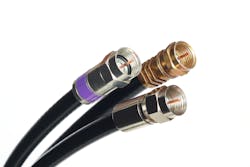CableLabs publishes DOCSIS 4.0 specification for 10 Gbps downstream, 6 Gbps upstream
CableLabs, which develops standards for U.S. cable network operators that are often adopted by cable operators internationally, says it has published the latest version of its Data Over Cable Service Interface Specification (DOCSIS). DOCSIS 4.0 leverages full-duplex and extended spectrum capabilities to enable 10-Gbps downstream and 6-Gbps upstream transmission rates over hybrid fiber/coax (HFC) architectures. The organization hails the specifications as an important step toward the goal of symmetrical 10G capabilities for HFC networks.
Full-duplex technology, specifications for which were completed in 2017, supports the delivery of multi-gigabit symmetrical services by enabling concurrent transmissions in different directions within the same spectrum. Self-interference cancellation technology and intelligent scheduling are keystones of this capability. The extended spectrum approach, as the name implies, expands the previous 1.2 GHz of usable spectrum to 1.6 GHz. Specifications for extended spectrum were completed last fall.
The downstream and upstream capabilities are significant improvements over the previous version of DOCSIS, DOCSIS 3.1. While that specification was initially described as enabling “up to” 10 Gbps downstream (and is still described that way in places on the CableLabs website as of today), CableLabs now classifies it as supporting only 5 Gbps downstream and (still) 1-2 Gbps upstream. A member of CableLabs’ media relations team explains that the initial DOCSIS 3.1 specifications began at 5 Gbps with an intention of evolving to 10-Gbps support in the future. The full-duplex efforts initially began under the DOCSIS 3.1 umbrella as a step toward achieving this goal. However, both the full-duplex and extended spectrum efforts were moved to DOCSIS 4.0 in June 2019, leaving DOCSIS 3.1 at 5 Gbps downstream.
The specification publication is the first of three steps necessary before certified DOCSIS 4.0 technology is ready for fielding. The next step includes interoperability events; information on the first such event has not been released. A program by which products can be certified as standards compliant would follow. In addition to the higher transmission rates, the DOCSIS 4.0 specifications cover means by which security and reliability can be improved.
For related articles, visit the FTTx Topic Center.
For more information on FTTx technology and suppliers, visit the Lightwave Buyer’s Guide.
To stay abreast of fiber network deployments, subscribe to Lightwave’s Service Providers and Datacom/Data Center newsletters.

Stephen Hardy | Editorial Director and Associate Publisher, Lightwave
Stephen Hardy is editorial director and associate publisher of Lightwave and Broadband Technology Report, part of the Lighting & Technology Group at Endeavor Business Media. Stephen is responsible for establishing and executing editorial strategy across the both brands’ websites, email newsletters, events, and other information products. He has covered the fiber-optics space for more than 20 years, and communications and technology for more than 35 years. During his tenure, Lightwave has received awards from Folio: and the American Society of Business Press Editors (ASBPE) for editorial excellence. Prior to joining Lightwave in 1997, Stephen worked for Telecommunications magazine and the Journal of Electronic Defense.
Stephen has moderated panels at numerous events, including the Optica Executive Forum, ECOC, and SCTE Cable-Tec Expo. He also is program director for the Lightwave Innovation Reviews and the Diamond Technology Reviews.
He has written numerous articles in all aspects of optical communications and fiber-optic networks, including fiber to the home (FTTH), PON, optical components, DWDM, fiber cables, packet optical transport, optical transceivers, lasers, fiber optic testing, and more.
You can connect with Stephen on LinkedIn as well as Twitter.
